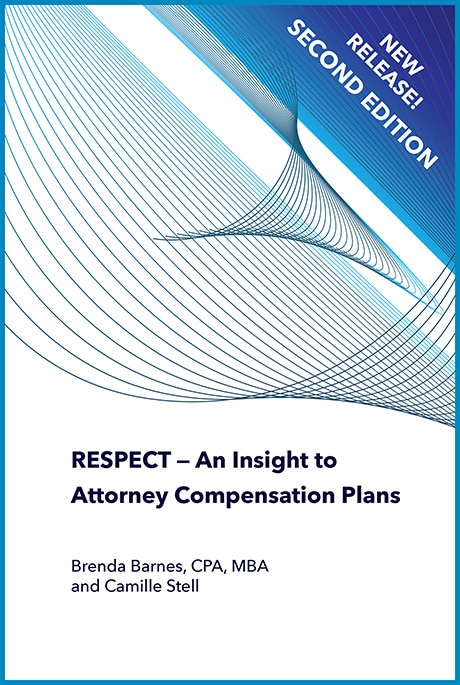Compensation is one of the most powerful levers a law firm has to shape behavior, reward success and signal its values. Camille Stell explores the hidden forces behind pay in law firms, emerging trends and legal compensation strategies for retaining top talent.

Table of contents
- The Hidden Forces Behind Pay in Law Firms: Trends, Biases and Solutions
- 5 Key Trends in Law Firm Compensation
- Does Your Comp Structure Align with Industry Standards and Employee Expectations?
- Common Biases in Law Firm Compensation
- Compensation Strategies to Reduce Bias and Improve Fairness
- The Hidden Forces Behind Pay in Law Firms
- Related Reading on Lawyer Compensation
The Hidden Forces Behind Pay in Law Firms: Trends, Biases and Solutions
Law firm compensation structures have undergone significant transformation over the past two decades. And with mounting pressure from clients, shifts in generational values, and a heightened awareness of workplace equity issues, firms are continuing to reevaluate compensation models They are seeking innovative ways to reward contributions, promote collaboration, and retain top talent while confronting systemic biases that have historically skewed rewards.
The following explores the latest trends in law firm compensation, provides best practices to determine whether your law firm is offering market salaries, and examines the inherent biases that can undermine fairness and transparency.
5 Key Trends in Law Firm Compensation
1. Move Toward Performance-Based Pay
Historically, many law firms, particularly large ones, operated under a lockstep compensation system where attorneys were paid based on seniority. This is still the norm among Biglaw firms.
An eat-what-you-kill model is often used in small firms. This model compensates attorneys based on their own originations and billings. This means each lawyer is financially incentivized to hoard work, focus on individual clients and matters, and limit time spent mentoring, managing or assisting colleagues.
Post-pandemic, there has been a shift toward performance-based models. Performance-based pay typically evaluates multiple dimensions of a lawyer’s contributions:
- Billable hours remain a foundational metric but are increasingly balanced with quality and client satisfaction.
- Business development, such as client origination and retention, is given substantial weight.
- Leadership and firm citizenship, including mentoring and management roles, are incorporated.
Many firms now use tiered bonus structures and discretionary awards to recognize individual and team achievements. This model is more dynamic but can introduce subjectivity if criteria are not clearly defined.
2. Increased Transparency
Transparency in compensation decisions is becoming a hallmark of progressive firms. For years, secrecy around pay fueled suspicion, dissatisfaction and turnover. Today, firms recognize that transparent systems foster trust and equity. Examples of transparency initiatives include:
- Publishing compensation bands for associates and income partners.
- Providing guidelines and metrics used in performance reviews.
- Using objective scorecards to assess performance across the board.
In partner compensation, transparency often means articulating how points or shares are allocated, who makes the decisions, and what behaviors are being rewarded. Transparency also extends to how lateral hires are integrated, preventing internal resentment and cultural disruption.
3. Recognition of Non-Billable Contributions
The legal industry is slowly embracing the idea that valuable contributions go beyond hours billed. Non-billable work often underpins a firm’s culture, growth and reputation. Examples of non-billable contributions that are gaining recognition include:
- Diversity, equity and inclusion (DEI) efforts, such as participation in affinity groups or DEI committees.
- Pro bono service, which enhances the firm’s public image and fulfills social responsibility mandates.
- Mentoring and training, especially when tied to retention and development of junior lawyers.
- Firm administration, including participation in hiring committees or knowledge management initiatives.
In some firms, these contributions are incorporated into annual reviews and bonus calculations. However, formal recognition remains inconsistent across the industry.
4. Emphasis on Retention and Culture
Retaining top talent is as critical as attracting it. Many law firms are rethinking compensation structures to align with evolving values, particularly among millennial and Gen Z attorneys. Strategies for retention-oriented compensation include:
- Offering sabbaticals or flexible work arrangements after a set tenure.
- Providing wellness stipends or mental health support as part of total compensation.
- Providing law school tuition reimbursement as a way of acknowledging crushing law school debt crippling an entire generation of young lawyers.
- Introducing tailored career tracks, such as staff attorney, non-equity partnership, or counsel roles, for lawyers seeking reduced hours without sacrificing dignity or growth.
- Promoting a collaborative culture by sharing origination credit or rewarding team achievements.
These strategies recognize that compensation is about more than money. It’s about feeling valued and supported.
5. Compensation Equity Audits
With increased scrutiny on systemic inequities, many firms are proactively conducting compensation equity audits. These audits analyze compensation data across race, gender and other protected characteristics to identify gaps. A thorough audit includes:
- Reviewing base salary, bonuses and originations.
- Comparing assignments and promotion opportunities.
- Conducting interviews or surveys to gather qualitative feedback.
Some firms also use third-party consultants to ensure objectivity. Top firms take corrective action when disparities are found and revise policies to prevent future inequities.
Does Your Comp Structure Align with Industry Standards and Employee Expectations?
Firms often wonder if their salaries are competitive. Here are best practices for determining whether attorney compensation aligns with market salaries in your practice areas and geographic locations.
1. Use Legal Industry Compensation Surveys
National and regional surveys provide benchmark data for legal positions:
- National Association for Law Placement (NALP) publishes salary surveys for associates and legal staff segmented by city and firm size.
- ALM Intelligence (American Lawyer Media) provides compensation data in the Law Firm Compensation Strategy Survey.
- Legal recruiting firms such as Major, Lindsey & Africa, as well as Robert Half Legal Salary Guide, offer annual reports on partner and associate salaries by geographic location and firm size, often with detailed analysis by region and practice area. Some survey editions provide salary percentiles (25th, 50th, 75th) and regional adjustments.
2. Consult Local Bar Associations and Law Firm Networks
Not as many state and local bar associations compile compensation reports or member surveys as in years past, but it is worth checking out the American Bar Association, state bar associations, practice-specific bars, and law firm peer networks such as the Managing Partner Forum. Even if these groups don’t publish compensation reports, they may share anonymized compensation data on salary trends through roundtables.
3. Leverage Online Salary Tools
Supplement industry surveys with tools like:
- Glassdoor or Indeed: Look up salaries for legal roles by city and firm size.
- PayScale: Customize search based on experience, location and title.
- Bureau of Labor Statistics: Review “Occupational Employment and Wage Statistics” for lawyers by metro area.
These sources may be less accurate for legal-specific roles and smaller markets, but they are helpful for context and as part of a more comprehensive search.
4. Evaluate Cost-of-Living and Local Economic Trends
Salaries should reflect several factors:
- Cost of living in the metro area.
- Competition (number of firms, law schools, alternative legal service providers).
- Client demand and billing rates in the practice area.
For example, a small estate planning firm in Charlotte, N.C., may not offer New York City-level salaries, but should still be competitive with peers in Raleigh and the Southeast. Use tools like:
- The cost of living calculator by NerdWallet or SmartAsset.
- Zillow for housing costs.
- Regional economic reports from your chamber of commerce or local law school career office.
5. Review Internal Metrics and Benchmarks
Assess whether compensation aligns with:
- Revenue per lawyer.
- Billable hour expectations.
- Collections and realization rates.
- Turnover rates or employee satisfaction trends.
If your firm’s productivity or profitability is high but salaries are below market, you may risk losing talent.
6. Engage a Law Firm Consultant
Legal management consultants can benchmark your firm against similar practices, provide confidential compensation reviews, and help you redesign incentive plans (e.g., bonuses, profit-sharing, flexible work).
7. Conduct a Staff and Attorney Survey
Ask current employees:
- Are they satisfied with their pay?
- What would make compensation more meaningful (e.g., health benefits, flexible work, bonuses)?
This can help gauge internal morale and retention risks.
Common Biases in Law Firm Compensation
Despite the rise of more sophisticated systems, bias continues to influence compensation decisions in subtle but powerful ways. Awareness of these biases is the first step toward creating fair and equitable processes.
1. Affinity Bias. Affinity bias occurs when decision-makers favor individuals with whom they share similarities, such as educational background, race, gender or interests. This can result in favorable work assignments and mentorships, more generous compensation offers, and accelerated promotion timelines. Affinity bias can skew performance evaluations and lead to unequal recognition.
2. Availability Bias. Attorneys who are more visible — either by working in the office more often or through self-promotion — may receive more credit, regardless of the substance of their work. Remote workers, introverted lawyers, or those balancing caregiving responsibilities may be disadvantaged if their contributions are less obvious to leadership. This can translate into smaller bonuses or missed promotion opportunities.
3. Gender Bias. Gender bias persists in how contributions are evaluated and rewarded. Female attorneys may be held to higher standards of proof for competency, face backlash for assertiveness that is praised in male counterparts, and receive less credit for business development, especially when they co-lead with men. Research shows women are more likely to be evaluated on personality traits, while men are judged on performance metrics. This can affect both compensation and partnership consideration.
4. Maternal Bias. Women with children often face assumptions that they are less committed to their careers. This bias can manifest in being passed over for complex or high-stakes matters, reduced access to client-facing roles, and lowered performance expectations, which then cap earnings. Maternal bias is a key factor in why many women leave law firms mid-career.
5. Racial and Ethnic Bias. Attorneys of color often face unique challenges in gaining access to the same opportunities as their white colleagues. These include fewer client introductions, less mentorship and sponsorship, and more scrutiny of mistakes and fewer chances to prove themselves. When these patterns are compounded over time, they result in wide compensation disparities that are not explained by performance alone.
6. Recency Bias. Recency bias refers to the tendency to weigh recent events more heavily than older ones. In law firms, this can distort performance reviews and bonus decisions. For example, a strong showing in the final quarter may overshadow earlier struggles — or vice versa. Lawyers who took parental leave or had a light caseload for part of the year may be unfairly penalized if contributions are not evaluated holistically.
Compensation Strategies to Reduce Bias and Improve Fairness
Firms that are serious about fair compensation must move beyond intentions to concrete actions. Some strategies include:
1. Structured Evaluation Frameworks
To reduce subjectivity, use standardized rubrics for performance reviews. Evaluation criteria should be clearly defined, with a balance of quantitative and qualitative measures.
2. Training and Accountability
Implement bias training for partners, compensation committee members, and reviewers. Training should go beyond compliance and focus on real-life scenarios and decision-making patterns.
Include diverse voices on compensation committees and ensure there is accountability for biased outcomes.
3. Originations and Credit Sharing
Revise origination credit systems to promote fairness. Encourage:
- Team-based credit sharing.
- Client relationship credits for those who maintain or grow accounts.
- Time-limited credits to prevent the entrenchment of rewards.
4. Annual Compensation Equity Audits
Review compensation data regularly and track progress over time. Transparency in reporting can help build trust and identify systemic issues early.
5. Recognizing Holistic Contributions
Broaden the definition of value to include firm-building activities such as DEI, mentorship and community involvement. These contributions should be formally tracked and tied to compensation decisions.
6. Inclusive Leadership Development
Invest in leadership programs that prepare underrepresented lawyers for senior roles. Promote transparency in promotion criteria and ensure all candidates have access to the same resources.
The Hidden Forces Behind Pay in Law Firms
Compensation is one of the most powerful levers a law firm has to shape behavior, reward success and signal its values. As the industry evolves, firms must be intentional about building systems that are transparent, inclusive and fair.
By recognizing and addressing the biases that creep into compensation decisions, and by embracing holistic, performance-driven models, law firms can foster a culture where all lawyers can thrive. The challenge is complex, but the reward is profound: a more equitable profession that better reflects the clients and communities it serves.

RESPECT: An Insight to Attorney Compensation Plans
Newly updated with more case studies.
Do you want to know more about designing and implementing compensation systems to grow and scale your law firm? Brenda Barnes and Camille Stell have written a go-to guide on attorney compensation trends and best practices for small to midsize law firms. Available at lawofficemanagementbooks.com and Amazon.
Related Reading on Lawyer Compensation
- “Black Box” Comp Plans vs. Percentage-Based Comp Plans by Erik Mazzone
- Everything You Need to Know About Modern Compensation Plans by Alexandra David
- Best Compensation Plans Follow the Rule of Thirds by Brooke Lively
- How Are Law Firm Owners Paid? by Brooke Lively
Image © iStockPhoto.com.

Sign up for Attorney at Work’s daily practice tips newsletter here and subscribe to our podcast, Attorney at Work Today.
















